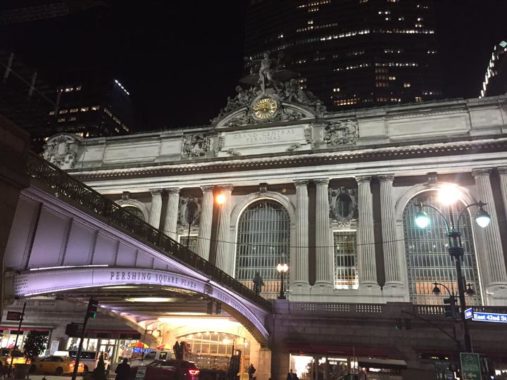The Park Avenue Viaduct opened in two pieces from East 40th to East 46th Streets in 1919 and 1928 surrounding Grand Central Terminal and later the Metropolitan Life (formerly Pan Am) Building. It has always been designed expressly for auto traffic and doesn’t have shoulders or sidewalks of any sort — hence its oddities, architecture and statuary are largely mysteries to all but the pedal to the metal motorists and cabbies who speed past them every day. This is actually the second Grand Central Terminal on this site — the first opened in 1873, and the current one in 1913.
If you want to call it Grand Central Station, be my guest! It’s properly a Terminal, and if I were correcting manuscripts, I’d ask for a change if it came to that, but I’m not going to be manic about it and correct you if I hear “Station” in convesation.
The Viaduct’s original streetlamps, or at least some of them, are still in place on the ramp between East 40th and East 42nd Streets. Grand Central Terminal belongs firmly in the Beaux-Arts tradition, and when the ramp was first proposed, its architecture was meant to echo the great building it surrounded. The viaduct also has decorative railings with a sea shell motif. (Compare the Brooklyn Bridge walkway lamps — they look like the originals but are actually copies from the early 1980s.)
Travel outside the building to see the sculpture “Transportation” by French artist Jules-Alexis Coutan that sits atop Grand Central Terminal. You will see Mercury flanked by Minerva and Hercules. Minerva is the goddess of wisdom and represents all the thought and planning put into this building. Mercury is the god of speed and represents both the speed of commerce as it grew up into midtown Manhattan from the financial district and, of course, the speed of trains. The mythological hero, Hercules, represents the strength of the men who built Grand Central. Carved out of Indiana limestone, the group stands 50 feet high and 60 feet wide, weighs 1,500 tons, and surmounts a clock 13 feet in diameter. [Grand Central Terminal]
Cornelius Vanderbilt stands athwart the one mode of transportation that he had nothing to do with — auto traffic. Normally viewable only from afar by lowly pedestrians, the statue stands at the head of the Park Avenue Viaduct where the roadway splits in two. It’s actually one of the oldest statues in Manhattan, having been sculpted in 1869 by Ernst Plassman and originally placed downtown at the Hudson River Freight Depot (now largely replaced by the Holland Tunnel entrance). The statue was moved to the south facade of Grand Central Terminal at its 1913 opening.
Check out the ForgottenBook, take a look at the gift shop, and as always, “comment…as you see fit.”
5/25/19
